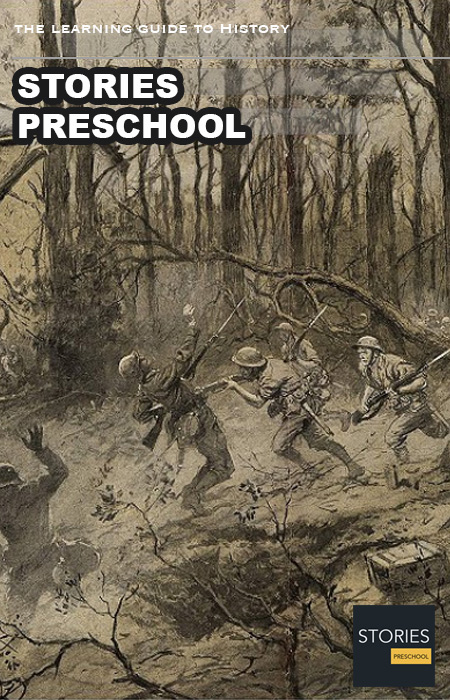World War I (1914-1918)

World War I (WWI or WW1), also known as the First World War, or the Great War, was a global war originating in Europe that lasted from 28 July 1914 to 11 November 1918. More than 70 million military personnel, including 60 million Europeans, were mobilized in one of the largest wars in history. Over 9 million combatants and 7 million civilians died as a result of the war (including the victims of a number of genocides), a casualty rate exacerbated by the belligerents' technological and industrial sophistication, and the tactical stalemate caused by gruelling trench warfare. It was one of the deadliest conflicts in history, and paved the way for major political changes, including revolutions in many of the nations involved.
The war drew in all the world's economic great powers, assembled in two opposing alliances: the Allies (based on the Triple Entente of the Britain The British Empire, was composed of the dominions, colonies, protectorates, mandates, and other territories ruled or administered by the United Kingdom and its predecessor states. At its height it was the largest empire in history and, for over a century, was the foremost global power. By the start of the 20th century, Germany and the United States had begun to challenge Britain's economic lead. , France
The British Empire, was composed of the dominions, colonies, protectorates, mandates, and other territories ruled or administered by the United Kingdom and its predecessor states. At its height it was the largest empire in history and, for over a century, was the foremost global power. By the start of the 20th century, Germany and the United States had begun to challenge Britain's economic lead. , France French Third Republic was the system of government adopted in France from 4 September 1870, when the Second French Empire collapsed during the Franco-Prussian War, until 10 July 1940, after the Fall of France during World War II led to the formation of the Vichy government. During the 19th and 20th centuries, the French colonial empire was the second largest colonial empire in the world only behind the British Empire. and the Russian Empire
French Third Republic was the system of government adopted in France from 4 September 1870, when the Second French Empire collapsed during the Franco-Prussian War, until 10 July 1940, after the Fall of France during World War II led to the formation of the Vichy government. During the 19th and 20th centuries, the French colonial empire was the second largest colonial empire in the world only behind the British Empire. and the Russian Empire Russian Empire was an empire and the final period of the Russian monarchy from 1721 to 1917, ruling across large parts of Eurasia. The rise of the Russian Empire coincided with the decline of neighbouring rival powers: the Swedish Empire, the Polish–Lithuanian Commonwealth, Qajar Iran, the Ottoman Empire, and Qing China. Russia remains the third-largest empire in history, surpassed only by the British Empire and the Mongol Empire. ) versus the Central Powers of Germany and Austria-Hungary. Although Italy was a member of the Triple Alliance alongside Germany
Russian Empire was an empire and the final period of the Russian monarchy from 1721 to 1917, ruling across large parts of Eurasia. The rise of the Russian Empire coincided with the decline of neighbouring rival powers: the Swedish Empire, the Polish–Lithuanian Commonwealth, Qajar Iran, the Ottoman Empire, and Qing China. Russia remains the third-largest empire in history, surpassed only by the British Empire and the Mongol Empire. ) versus the Central Powers of Germany and Austria-Hungary. Although Italy was a member of the Triple Alliance alongside Germany The German Empire, also referred to as Imperial Germany, the Second Reich, as well as simply Germany, was the period of the German Reich from the unification of Germany in 1871 until the November Revolution in 1918, when the German Reich changed its form of government from a monarchy to a republic. During its 47 years of existence, the German Empire became the industrial, technological, and scientific giant of Europe. and Austria-Hungary
The German Empire, also referred to as Imperial Germany, the Second Reich, as well as simply Germany, was the period of the German Reich from the unification of Germany in 1871 until the November Revolution in 1918, when the German Reich changed its form of government from a monarchy to a republic. During its 47 years of existence, the German Empire became the industrial, technological, and scientific giant of Europe. and Austria-Hungary Austria-Hungary, often referred to as the Austro-Hungarian Empire, the Dual Monarchy, or Austria, was a constitutional monarchy and great power in Central Europe between 1867 and 1918. Austria-Hungary was one of the Central Powers in World War I, which began with an Austro-Hungarian war declaration on the Kingdom of Serbia on 28 July 1914. , it did not join the Central Powers, as Austria-Hungary had taken the offensive, against the terms of the alliance. These alliances were reorganised and expanded as more nations entered the war: Italy, Japan
Austria-Hungary, often referred to as the Austro-Hungarian Empire, the Dual Monarchy, or Austria, was a constitutional monarchy and great power in Central Europe between 1867 and 1918. Austria-Hungary was one of the Central Powers in World War I, which began with an Austro-Hungarian war declaration on the Kingdom of Serbia on 28 July 1914. , it did not join the Central Powers, as Austria-Hungary had taken the offensive, against the terms of the alliance. These alliances were reorganised and expanded as more nations entered the war: Italy, Japan The Empire of Japan, also known as the Japanese Empire or Imperial Japan, was a historical nation-state and great power that existed from the Meiji Restoration in 1868 until the enactment of the post-World War II 1947 constitution and subsequent formation of modern Japan. Economic and political turmoil in the 1920s led to the rise of militarism, nationalism and totalitarianism eventually culminating in Japan's membership in the Axis alliance. and the United States
The Empire of Japan, also known as the Japanese Empire or Imperial Japan, was a historical nation-state and great power that existed from the Meiji Restoration in 1868 until the enactment of the post-World War II 1947 constitution and subsequent formation of modern Japan. Economic and political turmoil in the 1920s led to the rise of militarism, nationalism and totalitarianism eventually culminating in Japan's membership in the Axis alliance. and the United States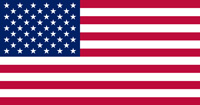 The United States of America (U.S.A. or USA), commonly known as the United States (U.S. or US) or America, is a country in North America. It is the world's third-largest country by both land and total area. The United States shares land borders with Canada to its north and with Mexico to its south. The national capital is Washington, D.C., and the most populous city and financial center is New York City. joined the Allies, while the Ottoman Empire
The United States of America (U.S.A. or USA), commonly known as the United States (U.S. or US) or America, is a country in North America. It is the world's third-largest country by both land and total area. The United States shares land borders with Canada to its north and with Mexico to its south. The national capital is Washington, D.C., and the most populous city and financial center is New York City. joined the Allies, while the Ottoman Empire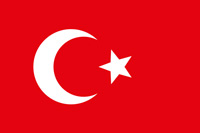 The Ottoman Empire, also known as the Turkish Empire, was an empire that controlled much of Southeast Europe, Western Asia, and Northern Africa between the 14th and early 20th centuries. The Ottomans ended the Byzantine Empire with the conquest of Constantinople in 1453. The Ottoman Empire's defeat and the occupation of part of its territory by the Allied Powers in the aftermath of World War I resulted in its partitioning and the loss of its Middle Eastern territories. and Bulgaria joined the Central Powers.
The Ottoman Empire, also known as the Turkish Empire, was an empire that controlled much of Southeast Europe, Western Asia, and Northern Africa between the 14th and early 20th centuries. The Ottomans ended the Byzantine Empire with the conquest of Constantinople in 1453. The Ottoman Empire's defeat and the occupation of part of its territory by the Allied Powers in the aftermath of World War I resulted in its partitioning and the loss of its Middle Eastern territories. and Bulgaria joined the Central Powers.
The trigger for the war was the assassination of Archduke Franz Ferdinand of Austria Austria, formally the Republic of Austria, is a country in the southern part of Central Europe, lying in the Eastern Alps. After the dissolution of the Holy Roman Empire in 1806, Austria established its own empire, which became a great power and the dominant member of the German Confederation. The empire's defeat in the Austro-Prussian War of 1866 led to the end of the Confederation and paved the way for the establishment of Austria-Hungary a year later., heir to the throne of Austria-Hungary, by Yugoslav nationalist Gavrilo Princip in Sarajevo on 28 June 1914. This set off a diplomatic crisis when Austria-Hungary delivered an ultimatum to the Kingdom of Serbia, and entangled international alliances formed over the previous decades were invoked. Within weeks, the major powers were at war and the conflict soon spread around the world.
Austria, formally the Republic of Austria, is a country in the southern part of Central Europe, lying in the Eastern Alps. After the dissolution of the Holy Roman Empire in 1806, Austria established its own empire, which became a great power and the dominant member of the German Confederation. The empire's defeat in the Austro-Prussian War of 1866 led to the end of the Confederation and paved the way for the establishment of Austria-Hungary a year later., heir to the throne of Austria-Hungary, by Yugoslav nationalist Gavrilo Princip in Sarajevo on 28 June 1914. This set off a diplomatic crisis when Austria-Hungary delivered an ultimatum to the Kingdom of Serbia, and entangled international alliances formed over the previous decades were invoked. Within weeks, the major powers were at war and the conflict soon spread around the world.
On 28 July, the Austro-Hungarians declared war on Serbia. As Russia mobilised in support of Serbia, Germany invaded neutral Belgium Belgium, officially the Kingdom of Belgium, is a country in Northwestern Europe. The country as it exists today was established following the 1830 Belgian Revolution. Belgium has also been the battleground of European powers, earning the moniker the "Battlefield of Europe", a reputation reinforced in the 20th century by both world wars. and Luxembourg before moving towards France, leading the United Kingdom to declare war on Germany. After the German march on Paris was halted, what became known as the Western Front settled into a battle of attrition, with a trench line that changed little until 1917. On the Eastern Front, the Russian army was successful against the Austro-Hungarians, but the Germans stopped its invasion of East Prussia. In November 1914, the Ottoman Empire joined the Central Powers, opening fronts in the Caucasus, Mesopotamia and the Sinai. In 1915, Italy
Belgium, officially the Kingdom of Belgium, is a country in Northwestern Europe. The country as it exists today was established following the 1830 Belgian Revolution. Belgium has also been the battleground of European powers, earning the moniker the "Battlefield of Europe", a reputation reinforced in the 20th century by both world wars. and Luxembourg before moving towards France, leading the United Kingdom to declare war on Germany. After the German march on Paris was halted, what became known as the Western Front settled into a battle of attrition, with a trench line that changed little until 1917. On the Eastern Front, the Russian army was successful against the Austro-Hungarians, but the Germans stopped its invasion of East Prussia. In November 1914, the Ottoman Empire joined the Central Powers, opening fronts in the Caucasus, Mesopotamia and the Sinai. In 1915, Italy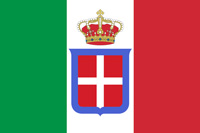 The Kingdom of Italy was a state that existed from 1861, when Victor Emmanuel II of Sardinia was proclaimed King of Italy, until 1946. The state resulted from a decades-long process, the Risorgimento, of consolidating the different states of the Italian Peninsula into a single state. That process was influenced by the Savoy-led Kingdom of Sardinia, which can be considered Italy's legal predecessor state. joined the Allies and Bulgaria joined the Central Power; Romania joined the Allies in 1916, as did the United States in 1917.
The Kingdom of Italy was a state that existed from 1861, when Victor Emmanuel II of Sardinia was proclaimed King of Italy, until 1946. The state resulted from a decades-long process, the Risorgimento, of consolidating the different states of the Italian Peninsula into a single state. That process was influenced by the Savoy-led Kingdom of Sardinia, which can be considered Italy's legal predecessor state. joined the Allies and Bulgaria joined the Central Power; Romania joined the Allies in 1916, as did the United States in 1917.
The Russian government collapsed in March 1917, and a revolution in November brought the Russians to terms with the Central Powers via the Treaty of Brest Litovsk, which was a massive German victory. After a stunning German offensive along the Western Front in the spring of 1918, the Allies rallied and drove back the Germans in a series of successful offensives. On 4 November 1918, the Austro-Hungarian empire agreed to an armistice, and Germany, which had its own trouble with revolutionaries, agreed to an armistice on 11 November 1918, ending the war in victory for the Allies.
By the end of the war, the German Empire, Russian Empire, Austro-Hungarian Empire and the Ottoman Empire ceased to exist. National borders were redrawn, with several independent nations restored or created, and Germany's colonies were parceled out among the winners. During the Paris Peace Conference of 1919, the Big Four (Britain, France, the United States and Italy) imposed their terms in a series of treaties. The League of Nations was formed with the aim of preventing any repetition of such a conflict. This effort failed, and economic depression, renewed European nationalism, weakened member states, and the German feeling of humiliation contributed to the rise of Nazism. These conditions eventually contributed to World War II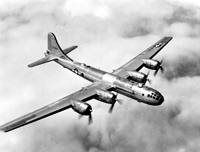 World War II or the Second World War, often abbreviated as WWII or WW2, was a world war that lasted from 1939 to 1945. It involved the vast majority of the world's countries—including all of the great powers—forming two opposing military alliances: the Allies and the Axis powers. World War II was a total war that directly involved more than 100 million personnel from more than 30 countries. World War II is generally considered to have begun on 1 September 1939, when Nazi Germany, under Adolf Hitler, invaded Poland. View World War II ».
World War II or the Second World War, often abbreviated as WWII or WW2, was a world war that lasted from 1939 to 1945. It involved the vast majority of the world's countries—including all of the great powers—forming two opposing military alliances: the Allies and the Axis powers. World War II was a total war that directly involved more than 100 million personnel from more than 30 countries. World War II is generally considered to have begun on 1 September 1939, when Nazi Germany, under Adolf Hitler, invaded Poland. View World War II ».
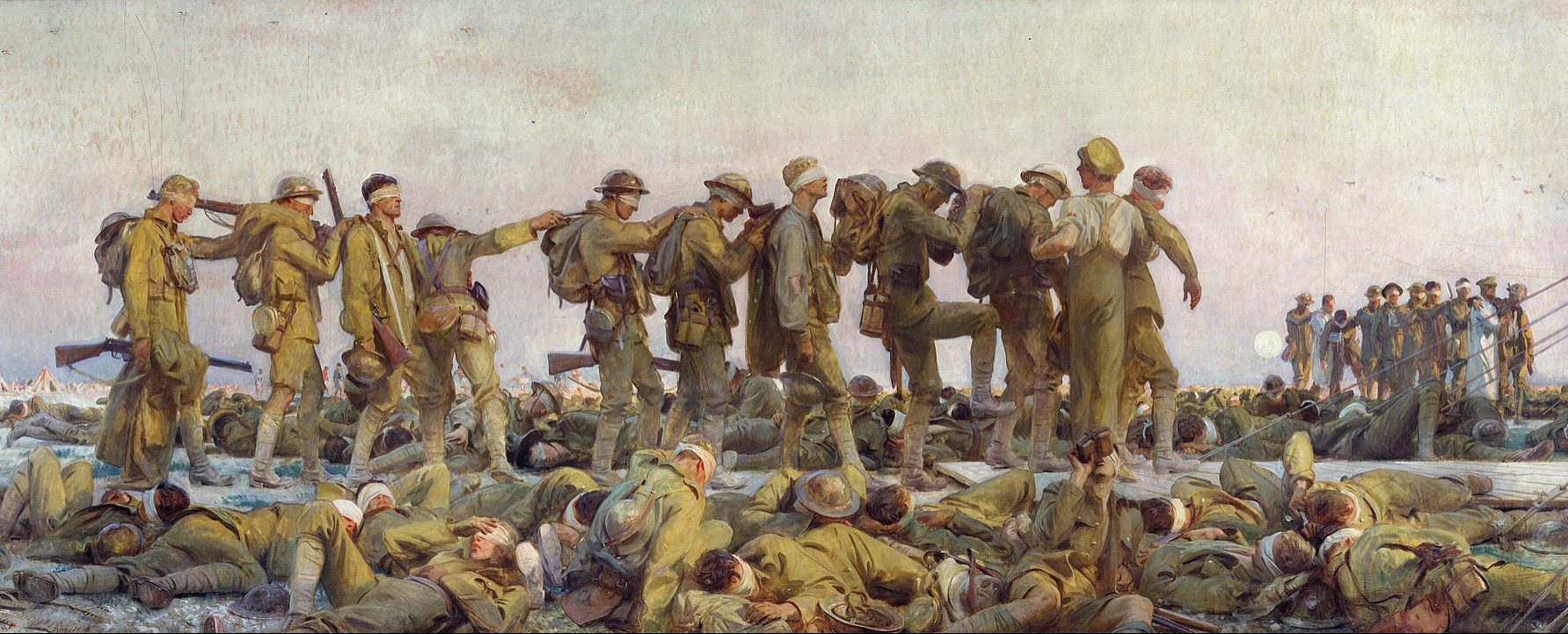
John Singer Sargent's Gassed presents a classical frieze of soldiers being led from the battlefield - alive, but changed forever by individual encounters with deadly hazard in war

John Singer Sargent's Gassed presents a classical frieze of soldiers being led from the battlefield - alive, but changed forever by individual encounters with deadly hazard in war
( Click image to enlarge)
Names of World War I
From the time of its start until the approach of World War II, the First World War was called simply the World War or the Great War and thereafter the First World War or World War I. At the time, it was also sometimes called "the war to end war" or "the war to end all wars" due to its then-unparalleled scale and devastation.
In Canada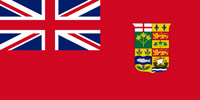 Canada is a country in North America. Because Britain still maintained control of Canada's foreign affairs under the British North America Act, 1867, its declaration of war in 1914 automatically brought Canada into World War I. Volunteers sent to the Western Front later became part of the Canadian Corps, which played a substantial role in the Battle of Vimy Ridge and other major engagements of the war., Maclean's magazine in October 1914 wrote, "Some wars name themselves. This is the Great War." During the interwar period (1918–1939), the war was most often called the World War and the Great War in English-speaking countries.
Canada is a country in North America. Because Britain still maintained control of Canada's foreign affairs under the British North America Act, 1867, its declaration of war in 1914 automatically brought Canada into World War I. Volunteers sent to the Western Front later became part of the Canadian Corps, which played a substantial role in the Battle of Vimy Ridge and other major engagements of the war., Maclean's magazine in October 1914 wrote, "Some wars name themselves. This is the Great War." During the interwar period (1918–1939), the war was most often called the World War and the Great War in English-speaking countries.
The term "First World War" was first used in September 1914 by the German biologist and philosopher Ernst Haeckel, who claimed that "there is no doubt that the course and character of the feared 'European War' ... will become the first world war in the full sense of the word," citing a wire service report in The Indianapolis Star on 20 September 1914. After the onset of the Second World War in 1939, the terms World War I or the First World War became standard, with British and Canadian historians favouring the First World War, and Americans World War I.
Background of War
Political and Military Alliances
For much of the 19th century, the major European powers maintained a tenuous balance of power among themselves, known as the Concert of Europe. After 1848, this was challenged by a variety of factors, including Britain's withdrawal into so-called splendid isolation, the decline of the Ottoman Empire and the rise of Prussia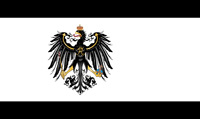 The Kingdom of Prussia was a German kingdom that constituted the state of Prussia between 1701 and 1918. It was the driving force behind the unification of Germany in 1871 and was the leading state of the German Empire until its dissolution in 1918. Although it took its name from the region called Prussia, it was based in the Margraviate of Brandenburg. Its capital was Berlin. under Otto von Bismarck. The 1866 Austro-Prussian War established Prussian hegemony in Germany, while victory in the 1870–1871 Franco-Prussian War allowed Bismarck to consolidate the German states into a German Empire under Prussian leadership. Avenging the defeat of 1871, or revanchism, and recovering the provinces of Alsace-Lorraine became the principal objects of French policy for the next forty years.
The Kingdom of Prussia was a German kingdom that constituted the state of Prussia between 1701 and 1918. It was the driving force behind the unification of Germany in 1871 and was the leading state of the German Empire until its dissolution in 1918. Although it took its name from the region called Prussia, it was based in the Margraviate of Brandenburg. Its capital was Berlin. under Otto von Bismarck. The 1866 Austro-Prussian War established Prussian hegemony in Germany, while victory in the 1870–1871 Franco-Prussian War allowed Bismarck to consolidate the German states into a German Empire under Prussian leadership. Avenging the defeat of 1871, or revanchism, and recovering the provinces of Alsace-Lorraine became the principal objects of French policy for the next forty years.
In order to isolate France and avoid a war on two fronts, Bismarck negotiated the League of the Three Emperors between Austria-Hungary, Russia and Germany. After Russian victory in the 1877–1878 Russo-Turkish War, the League was dissolved due to Austrian concerns over Russian influence in the Balkans, an area they considered of vital strategic interest. Germany and Austria-Hungary then formed the 1879 Dual Alliance, which became the Triple Alliance when Italy joined in 1882. For Bismarck, the purpose of these agreements was to isolate France by ensuring the three Empires resolved any disputes between themselves; when this was threatened in 1880 by British and French attempts to negotiate directly with Russia, he reformed the League in 1881, which was renewed in 1883 and 1885. After the agreement lapsed in 1887, he replaced it with the Reinsurance Treaty, a secret agreement between Germany and Russia to remain neutral if either were attacked by France or Austria-Hungary.
Bismarck viewed peace with Russia as the foundation of German foreign policy but after becoming Kaiser in 1890, Wilhelm II forced him to retire and was persuaded not to renew the Reinsurance Treaty by Leo von Caprivi, his new Chancellor. This provided France an opportunity to counteract the Triple Alliance, by signing the Franco-Russian Alliance in 1894, followed by the 1904 Entente Cordiale with Britain, and the Triple Entente was completed by the 1907 Anglo-Russian Convention. While these were not formal alliances, by settling long-standing colonial disputes in Africa and Asia, British entry into any future conflict involving France or Russia became a possibility. British and Russian support for France against Germany during the Agadir Crisis in 1911 reinforced their relationship and increased Anglo-German estrangement, deepening the divisions that would erupt in 1914.
Arms Race
German industrial and economic power had grown greatly after unification and the foundation of the Empire in 1871 following the Franco-Prussian War. From the mid-1890s on, the government of Wilhelm II used this base to devote significant economic resources for building up the Kaiserliche Marine (Imperial German Navy), established by Admiral Alfred von Tirpitz, in rivalry with the British Royal Navy for world naval supremacy. As a result, each nation strove to out-build the other in capital ships. With the launch of HMS Dreadnought in 1906, the British Empire expanded on its significant advantage over its German rival. The arms race between Britain and Germany eventually extended to the rest of Europe, with all the major powers devoting their industrial base to producing the equipment and weapons necessary for a pan-European conflict. Between 1908 and 1913, the military spending of the European powers increased by 50%.
Conflicts in the Balkans
Austria-Hungary precipitated the Bosnian crisis of 1908–1909 by officially annexing the former Ottoman territory of Bosnia and Herzegovina, which it had occupied since 1878. This angered the Kingdom of Serbia and its patron, the Pan-Slavic and Orthodox Russian Empire. Russian political manoeuvring in the region destabilised peace accords, which were already fracturing in the Balkans which came to be known as the "powder keg of Europe". In 1912 and 1913, the First Balkan War was fought between the Balkan League and the fracturing Ottoman Empire. The resulting Treaty of London further shrank the Ottoman Empire, creating an independent Albanian state while enlarging the territorial holdings of Bulgaria, Serbia, Montenegro, and Greece. When Bulgaria attacked Serbia and Greece on 16 June 1913, it lost most of Macedonia to Serbia and Greece and Southern Dobruja to Romania in the 33-day Second Balkan War, further destabilising the region.
List of World War I Battles 1914
1914 August
- Battle of Liège (5 August 1914): The opening engagement of the German invasion of Belgium and the first battle of World War I.
- Battle of Mulhouse (7 August 1914): The Battle was part of a French attempt to recover the province of Alsace.
- Battle of Halen (12 August 1914): The battle was a tactical victory for the Belgians but did little to delay the German invasion of Belgium.
- Battle of Lorraine (14 August 1914): The Battle of Lorraine was a battle of World War I fought in August 1914 between France and Germany.
- Battle of Stallupönen (17 August 1914): The Germans under the command of Hermann von François conducted a successful counterattack against four Russian infantry divisions.
- Battle of Charleroi (21 August 1914): The French were saved by a counter-attack at Dinant.
- Battle of the Ardennes (21 August 1914): The German armies defeated the French armies and forced the French armies to retreat.
- Battle of Rossignol (22 August 1914): French commander-in-chief General Joseph Joffre ordered an attack upon the centre of the German advance.
- Battle of Mons (23 August 1914): British were eventually forced to retreat due both to the greater strength of the Germans and the sudden retreat of the French Fifth Army.
- Battle of Galicia (23 August 1914): The Austro-Hungarian armies were severely defeated and forced out of Galicia.
- Battle of the Trouée de Charmes (24 August 1914): The Battle of the Trouée de Charmes was a victory for the French Second Army.
- Battle of Tannenberg (26 August 1914): The Battle resulted in the almost complete destruction of the Russian Second Army.
- Battle of Le Cateau (26 August 1914): Defensive positions in a fighting withdrawal against the German advance at Le Cateau-Cambrésis.
- Battle of St. Quentin (29 August 1914): The French resumed the offensive on the morning of 30 August but managed only disjointed attacks.
1914 September
- First Battle of the Marne (6 September 1914): The Battle was the culmination of the German advance into France and pursuit of the Allied armies which followed the Battle of the Frontiers in August and had reached the eastern outskirts of Paris.
- First Battle of the Masurian Lakes (7 September 1914): It pushed the Russian First Army back across its entire front, eventually ejecting it from Germany. Further progress was hampered by the arrival of the Russian Tenth Army on the Germans' left flank.
- First Battle of the Aisne (13 September 1914): When the Germans turned to face the pursuing Allies on 13 September, they held one of the most formidable positions on the Western Front.
- Battle of Flirey (19 September 1914): The Battle cut most of the roads and railways to the strategically important Fortified Region of Verdun (Région Fortifiée de Verdun [RFV]) and was to have a large effect on the course of the war.
- First Battle of Picardy (22 September 1914): The French Sixth Army attacked up the Oise river valley towards Noyon, as the Second Army assembled further north, ready to attempt to advance round the northern flank of the German 1st Army.
- Battle of Albert (25 September 1914): The Second Army (Noël de Castelnau), began to assemble at Amiens in mid-September and was directed by General Joseph Joffre, the Generalissimo of the French Army, to attack near Albert.
- Battle of the Vistula River (29 September 1914): The Battle of the Vistula River, also known as the Battle of Warsaw, was a Russian victory against the German Empire and Austria-Hungary on the Eastern Front during the First World War.
1914 October
- Battle of Arras (1 October 1914): The French were forced to withdraw towards Arras and Lens was occupied by German forces on 4 October.
- Battle of La Bassée (10 October 1914): The German 6th Army took Lille before a British force could secure the town and the 4th Army attacked the exposed British flank further north at Ypres.
- Battle of Messines (12 October 1914): The Battle of Messines was fought in October 1914 between the armies of the German and British empires, as part of the Race to the Sea, between the river Douve and the Comines–Ypres canal.
- Battle of Armentières (13 October 1914): The 6th Army began attacks from Arras north to Armentières in late October, which were faced by the BEF III Corps from Rouges Bancs, past Armentières north to the Douve river beyond the Lys.
- Battle of the Yser (16 October 1914): Victory at the Yser allowed Belgium to retain control of a sliver of territory, while making King Albert a Belgian national hero, sustaining national pride and providing a venue for commemorations of heroic sacrifice for the next century.
- First Battle of Ypres (19 October 1914): The Battle was part of the First Battle of Flanders, in which German, French and Belgian armies and the British Expeditionary Force (BEF) fought from Arras in France to Nieuport on the Belgian coast.
- Battle of Langemarck (21 October 1914): On 20 October, Langemarck, north-east of Ypres, was held by a French territorial unit and the British IV corps to the south.
- Battle of Gheluvelt (28 October 1914): Strict economies were imposed on the 6th Army formations further south, to provide artillery ammunition for 250 heavy guns allotted to support an attack to the north-west, between Gheluvelt and Messines.
1914 November
- Battle of Nonne Bosschen (9 November 1914): On 10 November, twelve and half German divisions of the 4th and 6th Armies, Armeegruppe Fabeck and XXVII Reserve Corps attacked from Nonne Bosschen and the edge of Polygon Wood.
- Battle of Łódź (11 November 1914): The Battle was fought between the German Ninth Army and the Russian First, Second, and Fifth Armies, in harsh winter conditions.
1914 December
- Battle of Limanowa (1 December 1914): The Austro-Hungarian high command had assumed that the German success would weaken Russian forces in the north and that the Galician front would remain quiet.
- Battle of the Falkland Islands (8 December 1914): The Battle of the Falkland Islands was a naval action between the British Royal Navy and Imperial German Navy on 8 December 1914, during the First World War in the South Atlantic.
- First Battle of Champagne (20 December 1914): The offensive was part of a strategy by the French army to attack the Noyon Salient, a large bulge in the new Western Front, which ran from Switzerland to the North Sea.
- Battle of Sarikamish (22 December 1914): Battle of Sarikamish was an engagement between the Russian and Ottoman empires during World War I.
List of World War I Battles 1915
1915 January
- Battle of Jassin (18 January 1915): The German commander, Paul Emil von Lettow-Vorbeck, decided to attack Jassin in order to prevent further danger to Tanga.
1915 February
- Defense of the Suez Badick (3 February 1915)
- Second Battle of the Masurian Lakes (7 February 1915): The offensive was intended to advance beyond the Vistula River and perhaps knock Russia out of the war.
- Dardanelles Bombardment (19 February 1915)
1915 March
- Battle of Neuve Chapelle (10 March 1915): The battle was intended to cause a rupture in the German lines, which would then be exploited with a rush to the Aubers Ridge and possibly Lille.
1915 April
- Battle of Shaiba (12 April 1915): By capturing Basra, the British had taken an important communications and industrial centre. The British had consolidated their hold on the city and brought in reinforcements.
- Second Battle of Ypres (22 April 1915): It was the first mass use by Germany of poison gas on the Western Front.
- Battle of Gravenstafel (22 April 1915): German troops carried 5,730 gas cylinders, weighing 90 pounds (41 kg) each, to the front by hand. The cylinders, opened by hand, relied on the prevailing wind to carry the gas towards enemy lines.
- Battle of St. Julien (24 April 1915): Fisher went out twice with a handful of men and a Colt machine gun, preventing advancing German troops from passing through St. Julien into the rear of the Canadian front line.
- Landing at Cape Helles (25 April 1915): The landing at Cape Helles was part of the amphibious invasion of the Gallipoli peninsula by British and French forces.
- First Battle of Krithia (28 April 1915): The attack broke down due to the defensive power of the Ottoman opposing forces, poor leadership and planning, lack of communications and exhaustion and demoralisation of the troops.
1915 May
- Battle of Eski Hissarlik (1 May 1915): The Battle of Eski Hissarlik took place on 1 May 1915 and was an attempt made by the Ottomans, commanded by Liman von Sanders to push Allied (British and French) troops back to the sea.
- Second Battle of Krithia (6 May 1915): The village of Krithia and neighbouring hill of Achi Baba had to be captured in order for the British to advance up the Gallipoli peninsula to the forts that controlled passage of the Dardanelles straits.
- Battle of Frezenberg (8 May 1915): The German attack began on 8 May with a bombardment of the 83rd Brigade in trenches on the forward slope of the ridge, but the first and second infantry assaults were repelled by the survivors.
- Battle of Festubert (15 May 1915): The Battle of Festubert (15–25 May 1915) was an attack by the British army in the Artois region of France on the western front during World War I.
- Turkish attack at Anzac Cove (19 May 1915)
- Battle of Bellewaarde Ridge (24 May 1915): On May 24 the Germans released a gas attack that hit Shell Trap Farm and to the area around the north west, which was affected the most by the attack.
- Capture of Amara (31 May 1915)
1915 June
- Third Battle of Krithia (4 June 1915): The previous failures in the first and second battles resulted in a less ambitious plan being developed for the attack, but the outcome was another costly failure for the Allies.
- Attempt to Force the Narrows (18 June 1915)
- First Battle of the Isonzo (23 June 1915): The aim of the Italian Army was to drive the Austrians away from its defensive positions along the Soča (Isonzo) and on the nearby mountains.
- Battle of Nasiriyeh (27 June 1915)
- Battle of Gully Ravine (28 June 1915): The preceding Third Battle of Krithia and the attack at Gully Ravine had limited objectives and had much in common with the trench warfare prevailing on the Western Front.
1915 July
- Attack on Ache Baba (12 July 1915)
- Second Battle of the Isonzo (18 July 1915): After the failure of the First Battle of the Isonzo, two weeks earlier, Luigi Cadorna, commander-in-chief of the Italian forces, decided for a new thrust against the enemy lines with a heavier artillery support.
1915 August
- Battle of Sari Bair (6 August 1915): The Battle of Sari Bair, also known as the August Offensive, was the final attempt made by the British in August 1915 to seize control of the Gallipoli peninsula from the Ottoman Empire during the First World War.
- Great Retreat (Russian) (17 August 1915): While the withdrawal itself was relatively well conducted, it was a severe blow to Russian morale.
- Battle of Hill 60 (Gallipoli) (21 August 1915): The first assault resulted in limited gains around the lower parts of the hill, but the Ottoman defenders managed to hold the heights even after the attack was continued by a fresh Australian battalion on 22 August.
- Battle of Scimitar Hill (21 August 1915): The purpose of the attack was to remove the immediate Ottoman threat from the exposed Suvla landing and to link with the ANZAC sectors to the south.
1915 September
- Third Battle of Artois (25 September 1915): The battle is also known as the Loos–Artois Offensive and included the big British offensive by the British First Army, known as the Battle of Loos.
- Battle of Loos (25 September 1915): It was the biggest British attack of 1915, the first time that the British used poison gas and the first mass engagement of New Army units.
- Second Battle of Champagne (25 September 1915): The German front position was broken in four places and two of the penetrations reached as far as the R-Stellung, where uncut barbed wire prevented the French from advancing further.
- Battle of Es Sinn (28 September 1915): The sides fought to determine control of the lower Tigres and Euphrates rivers, in what is now Iraq.
1915 October
- Morava Offensive (14 October 1915): In the beginning due to the harsh weather, strong resistance of the defenders and the tough terrain the Bulgarian advance was slow but because defenders were greatly outnumbered.
- Ovče Pole Offensive (14 October 1915): Its aim was to seize the Vardar river valley, and to cut the vital railway linking Skopje with Thesaloniki to prevent the Serbian Army from being resupplied and reinforced by the Allied Expeditionary Force.
- Third Battle of the Isonzo (18 October 1915): The main objectives were to take the Austro-Hungarian bridgeheads at Bovec (Plezzo in Italian) and Tolmin, if possible the town of Gorizia.
1915 November
- Fourth Battle of the Isonzo (10 November 1915): Most of the clash concentrated in the direction of Gorizia and on the Kras Plateau, though the push was distributed on the whole Isonzo front.
- Kosovo Offensive (10 November 1915): The battle began with the forcing of the South Morava by the Bulgarian 1st Army and ended with the total defeat of the Serbian army.
- Battle of Ctesiphon (22 November 1915): The Battle of Ctesiphon was fought in November 1915 by the British Empire and British India, against the Ottoman Empire, within the Mesopotamian Campaign of World War I.
1915 December
- Siege of Kut (7 December 1915): Historian Christopher Catherwood has called the siege "the worst defeat of the Allies in World War I".
- Evacuation of Gallipoli (18 December 1915)
List of World War I Battles 1916
1916 January
- Montenegrin Campaign of World War I (5 January 1916): The remnants of the Serbian army had withdrawn through Montenegro and Albania, and were being evacuated by allied ships from December 12, first to Italy and later to Corfu.
- Battle of Mojkovac (6 January 1916): Austro-Hungarian forces attacked the army's positions early that day along with a heavy artillery bombardment on Mojkovac itself.
- Battle of Sheikh Sa'ad (6 January 1916): The battle took place along the banks of the Tigris River between the Anglo-Indian Tigris Corps and elements of the Ottoman Sixth Army.
- Battle of Koprukoy (10 January 1916): The Russians achieved total surprise and broke through the Ottoman defenses, sending the Third Army retreating towards Erzurum.
- Battle of Wadi (13 January 1916): Pushed by regional British Commander-in-Chief Sir John Nixon, General Fenton Aylmer launched an attack against Ottoman defensive positions on the banks of the Wadi River.
- Battle of Hanna (21 January 1916): The well prepared Ottoman positions, notably the well-sited machine gun nests, forced them to abandon the assault and withdraw the relief force to the base of Ali Gharbi.
1916 February
- Battle of Verdun (21 February 1916): The battle was the largest and longest battle of the First World War on the Western Front between the German and French armies.
1916 March
- Battle of Dujaila (8 March 1916): The Ottoman forces, led by Colmar Freiherr von der Goltz were besieging Kut, when the Anglo-Indian relief force, led by Lieutenant-General Fenton Aylmer, attempted to relieve the city.
- Fifth Battle of the Isonzo (9 March 1916): The Italians, under immense pressure from the French commanders, had decided to launch another offensive on the Soča (Isonzo) River.
- Lake Naroch Offensive (18 March 1916): Due to lack of reconnaissance, Russian artillery support failed to overcome and neutralise the well-fortified German defenses and artillery positions, leading to costly and unproductive direct attacks, hindered by the weather.
1916 May
- Battle of Ninigalo (15 May 1916)
- Battle of Asiago (15 May 1916): Already for some time the Austrian commander-in-chief, General Conrad von Hötzendorf, had been proposing the idea of a Strafexpedition that would lethally cripple Italy.
- Battle of Jutland (31 May 1916): It was the largest naval battle and the only full-scale clash of battleships in that war. Jutland was the last major battle in world history fought primarily by battleships.
1916 June
- Battle of Lutsk (4 June 1916): The Russian 8th Army made a decisive breakthrough in the defenses of the Austro-Hungarian Fourth Army.
- Battle of Khanaqin (4 June 1916)
1916 July
- Battle of the Somme (1 July 1916): More than three million men fought in this battle and one million men were wounded or killed, making it one of the bloodiest battles in human history.
- Battle of Albert (1 July 1916): The Allied preparatory artillery bombardment commenced on 24 June and the Anglo-French infantry attacked on 1 July, on the south bank from Foucaucourt to the Somme and from the Somme north to Gommecourt, 2 mi (3.2 km) beyond Serre.
- Battle of Bazentin Ridge (14 July 1916): Attempts to use the opportunity to capture High Wood failed due to the German success in holding on to the north end of Logueval and parts of Delville Wood, from which attacks on High Wood could be engaged from the flank.
- Battle of Delville Wood (14 July 1916): General Douglas Haig, Commander of the British Expeditionary Force, intended to capture the German second position between Delville Wood and Bazentin le Petit.
- Battle of Fromelles (19 July 1916): General Headquarters (GHQ) of the British Expeditionary Force (BEF) had ordered the First and Second armies to prepare attacks to support the Fourth Army on the Somme 50 mi (80 km) to the south, to exploit any weakening of the German defences opposite.
- Battle of Pozières (23 July 1916): The costly fighting ended with the British in possession of the plateau north and east of the village, in a position to menace the German bastion of Thiepval from the rear.
1916 August
- Battle of Romani (3 August 1916): The Battle of Romani was the last ground attack of the Central Powers on the Suez Canal at the beginning of the Sinai and Palestine Campaign during the First World War.
- Sixth Battle of the Isonzo (6 August 1916): The Sixth Battle of the Isonzo also known as the Battle of Gorizia was the most successful Italian offensive along the Soča (Isonzo) River during World War I.
1916 September
- Battle of Guillemont (3 September 1916): The Fourth Army had advanced close to Guillemont during the Battle of Bazentin Ridge (14–17 July) and the capture of the village was the culmination of British attacks which began on 22/23 July.
- Seventh Battle of the Isonzo (14 September 1916): A short, sharp encounter fought from 14-17 September 1916, the Seventh Battle of the Isonzo saw Italian Chief of Staff Luigi Cadorna shift his focus from broad-based diversionary attacks to tightly focused initiatives directed at single targets.
- Battle of Flers–Courcelette (15 September 1916): The Anglo-French attack of 15 September began the third period of the Battle of the Somme but by its conclusion on 22 September, the strategic objective of a decisive victory had not been achieved.
1916 October
- Eighth Battle of the Isonzo (10 October 1916): Italian Chief of Staff Luigi Cadorna was determined to continue Italian attacks to the left of the town, a policy that continued during the following (ninth) battle - with an equal lack of success.
1916 November
- Ninth Battle of the Isonzo (1 November 1916): With the ninth battle fought from 1–4 November 1916 the combined casualty total from the three linked battles proved sufficiently heavy to ensure that each attack was of short duration.
1916 December
- Battle of Magdhaba (23 December 1916): This Egyptian Expeditionary Force (EEF) victory against the Ottoman Empire garrison also secured the town of El Arish after the Ottoman garrison withdrew.
List of World War I Battles 1917
1917 January
- Battle of Khadairi Bend (9 January 1917)
1917 February
- Battle of Nahr-al Kalek Bend (26 February 1917)
1917 March
- Capture of Baghdad (11 March 1917)
- Samarrah Offensive (13 March 1917): After Baghdad fell to the British on March 11, 1917, there were still 10,000 Ottoman troops north of the city, led by Khalil Pasha, who could represent a threat to Anglo-Indian forces.
- Seizure of Falluja (19 March 1917)
- Battle of Mount Hamrin (25 March 1917): The Battle of Mount Hamrin was an unsuccessful British effort to cut off part of the Ottoman Sixth Army after the capture of Baghdad during the Mesopotamia campaign during the First World War.
- First Battle of Gaza (26 March 1917): Fighting took place in and around the town of Gaza on the Mediterranean coast when infantry and mounted infantry from the Desert Column, a component of the Eastern Force, attacked the town.
1917 April
- Second Battle of Arras (9 April 1917): The British achieved the longest advance since trench warfare had begun, surpassing the record set by the French Sixth Army on 1 July 1916.
- First Battle of Bullecourt (11 April 1917)
- Battle of Doiran (22 April 1917): During the Second conference of the Military Counsel of the Entente in Chantilly, it was decided to continue with the attempts at a breakthrough.
1917 May
- Second Battle of Bullecourt (3 May 1917)
- Tenth Battle of the Isonzo (12 May 1917): Casualties suffered to date were tremendous and with each renewed battle tended to be higher on the Italian attackers side.
- Battle of the Strait of Otranto (14 May 1917): The Otranto Barrage was a fixed barrier, composed of lightly armed drifters with anti-submarine nets coupled with minefields and supported by Allied naval patrols.
1917 June
- Battle of Messines (7 June 1917): The Nivelle Offensive in April and May had failed to achieve its more ambitious aims, had led to the demoralisation of French troops and dislocated the Anglo-French strategy for 1917.
1917 July
- Battle of Passchendaele (31 July 1917): Also known as the Third Battle of Ypres, was a campaign of the First World War, fought by the Allies against the German Empire.
1917 August
- Eleventh Battle of the Isonzo (19 August 1917): The Italians crossed the river at several points on temporary bridges, but the main effort was exerted on the Banjšice Plateau.
- Battle of Liege (20 August 1917)
1917 September
- Battle of Ramadi (28 September 1917): The town's strategic position on the road between Aleppo and Baghdad made it a key British target during the Mesopotamian campaign.
1917 October
- Battle of Caporetto (24 October 1917): Austro-Hungarian forces, reinforced by German units, were able to break into the Italian front line and rout the Italian forces opposing them.
- Third Battle of Gaza (31 October 1917): Despite having held this line since March 1917, the Ottoman Army was forced to evacuate Gaza and Tel el Khuweilfe during the night of 6/7 November.
- Battle of Beersheba (31 October 1917)
1917 November
- Capture of Tikrit (5 November 1917)
- Battle of Mughar Ridge (13 November 1917): Strong Ottoman Army positions from Gaza to the foothills of the Judean Hills had successfully held out against British Empire forces for a week after the Ottoman army was defeated at Beersheba.
- Battle of Cambrai (20 November 1917): A British attack followed by the biggest German counter-attack against the British Expeditionary Force (BEF) since 1914, in the First World War.
1917 December
- Fall of Jerusalem (8 December 1917)
List of World War I Battles 1918
1918 March
- Second Battle of Somme/Operation Michael (21 March 1918): Operation Michael was a major German military offensive during the First World War that began the Spring Offensive on 21 March 1918.
- Battle of St. Quentin 21–23 March: Trench mortars, mustard gas, chlorine gas, tear gas and smoke canisters were concentrated on the forward trenches, while heavy artillery bombarded rear areas to destroy Allied artillery and supply lines.
- Actions at the Somme Crossings 24–25 March: By now, the front line was badly fragmented and highly fluid, as the remnants of the divisions of the Fifth Army were fighting and moving in small bodies, often composed of men of different units.
- First Battle of Bapaume 24–25 March: After three days the infantry was exhausted and the advance bogged down, as it became increasingly difficult to move artillery and supplies over the Somme battlefield of 1916 and the wasteland of the 1917 German retreat to the Hindenburg Line.
- Battle of Rosières 26–27 March: French forces on the extreme right (south) of the line under the command of General Fayolle were defeated and fell back in the face of protracted fighting; serious gaps appeared between the retreating groups.
- First Battle of Arras 28 March: Twenty-nine divisions attacked the Third Army and were repulsed.
1918 April
- Battle of the Avre 4 April 1918: It came on 4 April, when fifteen divisions attacked seven Allied divisions on a line east of Amiens and north of Albert (towards the Avre River).
- Battle of the Ancre 5 April: An attempt by the Germans to renew the offensive on 5 April failed and by early morning, the British had forced the enemy out of all but the south-eastern corner of the town.
- Battle of the Lys (7–29 April 1918): Also known as the Lys Offensive, the Fourth Battle of Ypres, the Fourth Battle of Flanders and Operation Georgette, was part of the 1918 German offensive in Flanders during World War I, also known as the Spring Offensive.
- Battle of Estaires (9–11 April)
- Battle of Messines (10–11 April)
- Battle of Hazebrouck (12–15 April)
- Battle of Bailleul (13–15 April)
- First Battle of Kemmel (17–19 April)
- Battle of Béthune (18 April)
- Second Battle of Kemmel (25–26 April)
- Battle of the Scherpenberg (29 April)
1918 May
- Third Battle of the Aisne (27 May 1918): It was one of a series of offensives, known as the Kaiserschlacht, launched by the Germans in the spring and summer of 1918.
- Battle of Cantigny (28 May 1918): The first major American battle and offensive of World War I. The U.S. 1st Division, the most experienced of the five American divisions then in France and in reserve for the French Army near the village of Cantigny, was selected for the attack.
1918 June
- Battle of Belleau Wood (1–26 June 1918): The Battle of Belleau Wood (1–26 June 1918) occurred during the German Spring Offensive in World War I, near the Marne River in France.
1918 July
- Second Battle of the Marne (15 July 1918): The Second Battle of the Marne, or Battle of Reims (15 July – 6 August 1918) was the last major German offensive on the Western Front during the First World War.
- Battle of Château-Thierry (18 July 1918): The Battle of Château-Thierry was fought on July 18, 1918 and was one of the first actions of the American Expeditionary Forces (AEF) under General John J. "Black Jack" Pershing.
1918 August
- Hundred Days Offensive (8 August – 11 November 1918): The Hundred Days Offensive was the final period of the First World War, during which the Allies launched a series of offensives against the Central Powers on the Western Front, beginning with the Battle of Amiens.
- Battle of Amiens (8 August 1918): The Battle of Amiens, also known as the Third Battle of Picardy, was the opening phase of the Allied offensive which began on 8 August 1918.
- Second Battle of the Somme (21 August 1918): The Second Battle of the Somme of 1918 was fought during the First World War on the Western Front from late August to early September, in the basin of the River Somme.
1918 September
- Battle of Saint-Mihiel (12 September 1918): The Battle of Saint-Mihiel was a major World War I battle fought from 12–15 September 1918, involving the American Expeditionary Force (AEF) and 110,000 French troops against German positions.
- Battle of Épehy (18 September 1918): The Battle of Épehy was a battle of the First World War fought on 18 September 1918, involving the British Fourth Army against German outpost positions in front of the Hindenburg Line.
- Meuse-Argonne Offensive (26 September 1918): The Meuse-Argonne Offensive was the largest in United States military history, involving 1.2 million American soldiers.
- Battle of St Quentin Canal (29 September 1918): The assault achieved its objectives, resulting in the first full breach of the Hindenburg Line, in the face of heavy German resistance.
1918 October
- Battle of Cambrai (8 October 1918): The Battle of Cambrai, 1918 was a battle between troops of the British First, Third and Fourth Armies and German Empire forces during the Hundred Days Offensive of the First World War.
1918 November
- Battle of the Sambre (4 November 1918): The Second Battle of the Sambre (4 November 1918) which included the Second Battle of Guise and the Battle of Thiérache was part of the final European Allied offensives of World War I.
HISTORY

RESOURCES
This article uses material from the Wikipedia articles "World War" and "World War I", which is released under the Creative Commons Attribution-Share-Alike License 3.0.
© Stories Preschool. All Rights Reserved.
